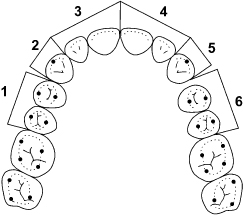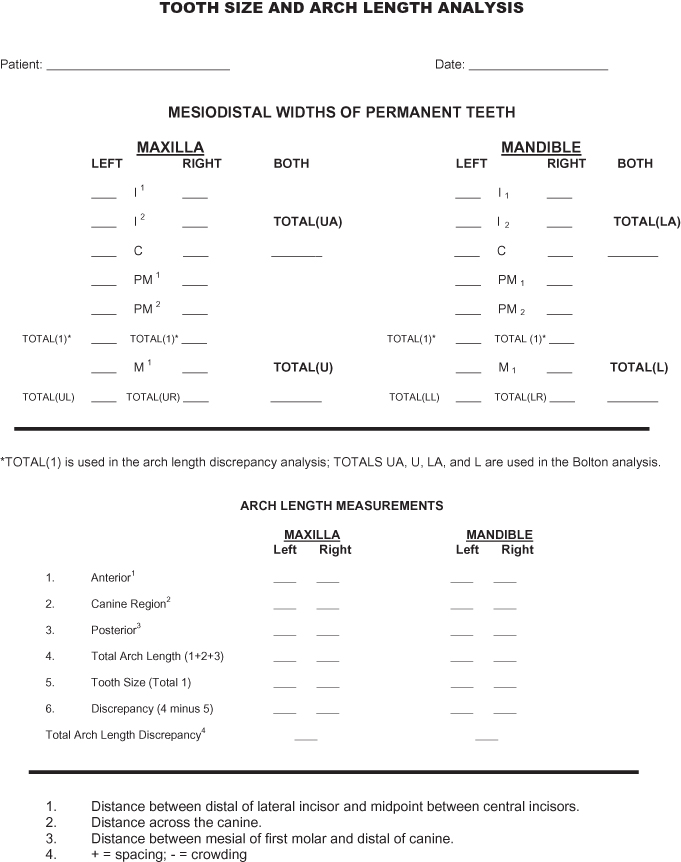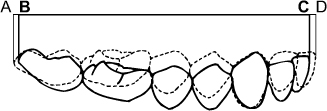3
Dental Cast Analysis in Adults
Tooth Size–Arch Length Analysis
The measurement of tooth widths, arch lengths, and arch widths and computation of tooth size–arch length discrepancies (TSALDs) are important ways to practice evidence-based orthodontics. Taking these measurements will demonstrate how a patient differs from a representative sample of persons with normal occlusion. A tooth size–arch length analysis is needed for patients who have crowded or spaced teeth in one or both arches. This analysis quantifies the amount of crowding or spacing. An accurate measurement of crowding or spacing is key for any proposed orthodontic treatment. In the assessment of a crowded permanent dentition, the lower arch has primacy over the upper arch, because the smaller size of the anterior mandibular alveolar structure limits the possibility for movement of anterior teeth. In adults, forward movement of crowded incisors can result in the loss of gingiva and bone labial to the teeth. For these reasons, an analysis of arch length and assessment of alveolar and gingival tissues are more critical in the mandibular arch than in the maxillary arch.
Measurement of Tooth Size and Arch Length
To determine the amount of crowding or spacing in an arch, subtract the sum of widths of the teeth mesial to the first molars from the sum of arch lengths mesial to the first molars. A crowded arch has a negative remainder, and the arch with spaces has a positive remainder. The acronym TSALD describes both crowding and spacing. UTSALD is used to describe upper arch discrepancies, and LTSALD is used to describe lower arch discrepancies.
The teeth measured for determining the TSALD are the incisors, canines, and premolars. The size of a tooth is measured as the width between its mesial and distal anatomic contact points. When a tooth is rotated, its width is measured between the anatomic contact points, not between the actual contact points. Usually the measurement is taken from the buccal or labial surface of the tooth. When a tooth is rotated, the best approach is to measure its width from the incisal or occlusal surface of the tooth’s crown.
Arch length is measured from the mesial surface of the first molar on the right side around the arch to the mesial surface of the first molar on the left side in six segments (Fig. 3.1). The line of arch consists of a line along the crest of an alveolar ridge that represents where the anatomic contact points of the teeth should be located ideally on a given alveolar ridge. Arch length measurements are an estimate of the length of the true line of arch mesial to the first molars in an arch. Hovda (1987) compared five different methods for measuring arch length on casts: (1) dial calipers, (2) brass wire method, (3) Brader Arch Forms method, (4) an F-curve ruler, and (5) the Reflex Metrograph (Ross Instruments Ltd., Salisbury, Wiltshire, England), a research instrument acting as the control. He found that measuring six segments around an arch with a dial calipers was the most reliable and repeatable method for measuring arch length. On the basis of these findings, we recommend using calipers or a Boley gauge, with sharpened measuring arm tips.
Figure 3.1. Segmental arch length measurements in an adult upper arch.

The six segments around the upper arch are illustrated in Figure 3.1. The tips of the measurement instrument are placed between the teeth below the contact points at the height or peak of the gingival papillae on the buccal and labial sides of the arches. Typical segments include (1) from the papilla between the first molar and second premolar to the papilla between the canine and first premolar, (2) from the papilla between the first premolar and the canine to the papilla between the canine and lateral incisor, and (3) from the papilla between the canine and lateral incisor to the papilla midway between the central incisors. The segments should not overlap or have gaps between them. Because many measurements are taken, repeating a measurement can help assure an accurate result. Practicing measurement techniques on a well-aligned arch, in which the goal is zero crowding, would be a helpful exercise for a beginner.
A form for collecting tooth size and arch length measurements is shown in Figure 3.2.
Figure 3.2. Form to collect tooth size and arch length measurements.

Factors Influencing a Tooth Size–Arch Length Analysis
A TSALD must be considered one part of a larger diagnosis. A number of other important factors associated with TSALDs are discussed next. In addition to these factors, treatment procedures such as rapid palatal expansion increase arch perimeter (arch length) in an upper arch (Adkins, Nanda, and Currier 1990).
Curve of Spee
When the upper and lower teeth are observed in occlusion from the side, the teeth usually conform, in the anteroposterior plane, to a curve known as the curve of Spee. The curve of Spee is leveled during orthodontic treatment. During leveling of the lower arch, the incisors move labially (Fig. 3.3). Figure 3.3 does not represent the tooth movements and forces that occur in the leveling of a lower arch. Figure 3.3 illustrates that the leveled arch will be longer in its anteroposterior length than the curved arch, if prior to treatment no spaces are found between the teeth or the teeth are crowded and if the width of the lower arch is maintained during treatment. If prior to treatment the lower incisors are either in a satisfactory anteroposterior position or inclined too far labially, leveling the curve of Spee may move the incisors too far in the labial direction. If sufficient excess arch length exists in an arch, incisors can be leveled without moving them too far labially as the curve of Spee is leveled.
Figure 3.3. Leveling of the curve of Spee. Arch length before leveling (B–C). Arch length after leveling (A–D).

Baldridge (1969) studied 30 patients who had exaggerated curves of Spee in their mandibular arches with all the permanent teeth erupted, except the third molars. He found the mean additional arch length required in the lower arch for leveling without labial tipping of the incisors was 3.54 ± 0.14 mm, with a minimum of 2.3 and a maximum of 5.2 mm. As the curve of Spee becomes more exaggerated, arch length deficiency increases. Baldridge developed a method for predicting the additional arch length required for leveling a particular arch without moving the incisors too far labiall/>
Stay updated, free dental videos. Join our Telegram channel

VIDEdental - Online dental courses


